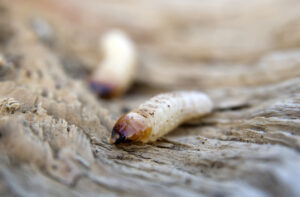
Need Help? Call Us On 0161 776 9832 For Expert Pest Control Advice On How To Identify Pest Infestations And Help Solve Your Pest Problem.
Professional Stalybridge Woodworm Treatment
Tiny holes in the surface of furniture or woodwork are a sign that woodworm is present. These are caused by beetle larvae, which burrow into the timber to feed on it. The tunnels made by the larvae as they chew through the wood can weaken it significantly. By the time the tell-tale symptoms of woodworm appear, structural damage has already begun. It's very important that a woodworm infestation is recognised and dealt with as quickly as possible.
The holes left by burrowing larvae are round or oval, typically between about 1.5 to 2 millimetres in diameter, and have sharp, fresh-looking edges. Other signs of an infestation may also be present. These include:
 • "Frass" or bore dust: powdery dust and tiny pellets on the floor or surfaces below the affected wood.
• "Frass" or bore dust: powdery dust and tiny pellets on the floor or surfaces below the affected wood.
• "Galleries" or tunnels in the wood.
• Crumbling wood (especially around the corners and ends of planks, floorboards and joists).
• Weak and damaged wood (in extreme cases, furniture may break when used, and floorboards may give way under pressure).
• Adult beetles (these usually emerge between May and October, although dead adults may be found at other times of the year).
• Larvae (whitish, maggot-like worms, generally curved in shape).
Woodworm infestations sometimes occur when an item of wooden furniture carrying eggs, pupae or larvae is brought into the home, and the signs of an infestation are often first noticed on items of furniture. The beetle larvae will feed on any timber, however, including doors, door and window frames, floorboards and wooden joists. When it comes to Stalybridge woodworm treatment furniture should not be the only consideration.
 In the UK, "woodworm" usually refers to the Common Furniture Beetle (Anobium punctatum) but the term can also refer to other species. The species must be identified so that the correct treatment for woodworm removal can be applied. The House Longhorn Beetle and Deathwatch Beetle don't respond to treatments aimed at destroying the Common Furniture Beetle, for example.
In the UK, "woodworm" usually refers to the Common Furniture Beetle (Anobium punctatum) but the term can also refer to other species. The species must be identified so that the correct treatment for woodworm removal can be applied. The House Longhorn Beetle and Deathwatch Beetle don't respond to treatments aimed at destroying the Common Furniture Beetle, for example.
If a woodworm infestation is suspected, a reputable pest control company should immediately be called in. The longer the infestation is left unchecked, the worse the damage will be. Simply replacing damaged timbers or furnishings won't control the problem, as the woodworm will attack the new wood. The beetles themselves must be completely eradicated.
Infestations are typically dealt with using Stalybridge woodworm treatment spray to kill the insects themselves. It may also be necessary to replace badly damaged floorboards or structural elements. Rather than apply Stalybridge woodworm removal treatment, furniture may need to be disposed of.
While it may be tempting to try a DIY treatment for woodworm, it's better to seek professional advice. An experienced surveyor can accurately identify the type of beetle causing the problem and can assess the spread of the infestation more effectively than a layperson. They will also be able to check for other problems that are often associated with woodworm, including damp and dry rot. Stalybridge woodworm treatment spray needs careful handling to be applied safely and effectively. It's especially important to have extensive infestations dealt with by professionals.
